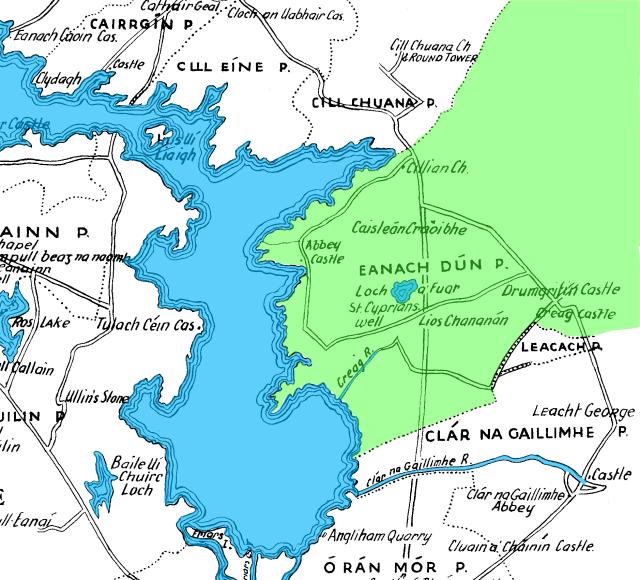Chapter 4: Eanach Dúin (Annaghdown) to Coill Beag
- Parish of Annaghdown
- Disaster of Annaghdown
- Monastery and Abbey
- Nunnery
- Bellhouse
- Annaghdown Castle
- Craobh Castle
- Kilcoona Round Tower
- St. Cuana
- Cloch-an-Uabhair Castle
- Lee's Island
- Cnoc Ferry and Coill Beag
Return to table of contents
Refer to Map

Eanach Dúin, the dun or "fortress of the bog"--and in modern Irish Eanach Cuan,
"the harbour of the bog," or possibly of St. Cuana--giving name to a large
parish in the barony of Clár, about

It is stated in the "Book of Ballymote" that Aodh, son of Eochaí Tirmcharna, King of Connacht, bestowed Enaghdún on God and St. Brendan of Cluain Fearta; and it is probable that the ancient see of Cunga was transferred here early in the twelfth century.
St. Brendan, having established a nunnery, and placed his sister Briga, a canoness of the Augustinian Order, over it, died here, but was interred at Cluain Fearta, A.D. 577. Several of its bishops are mentioned in the Irish Annals; but the episcopal lords of the neighbouring diocese of St. Iarlaith, and especially Archbishop Mac Aodha, feeling perhaps some jealousy on the subject, induced Pope John XXII in 1321 to issue a bull to suppress it, and join it to that of Tuaim; and many of its revenues and valuables were transferred to the collegiate church of St. Nicholas in Galway. The mandate of the Pontiff does not, however, appear to have been implicitly obeyed either by the Irish or English; for some of its bishops are enumerated after that date; and, so late as 1484, Richard III "dispatched to Ireland Thomas Barrett, a cleric of Somerset, who had been appointed to the bishopric of Enagh-dun, in Connacht, to instruct the Deputy Kildare by all possible means to bring into the King's power the Earldom of Ulster, then almost entirely possessed by the native Irish." And in order to conciliate the Desmond of the day, the Bishop brought a royal message that he should "renounce the waringe and usage of the Irish array;" and presented him with the King's livery, consisting of a collar of gold weighing twenty ounces; and from the King's wardrobe a long gown of cloth of gold lined with satin, doublets of velvet and crimson satin; stomachers, shirts, and kerchiefs; hose of scarlet, violet and black colours; bonnets, hats, and tippets of velvet, etc. But, gorgeous and enticing as this English "array" was, it will not bear comparison with that of Cormac Mac Airt many centuries before, as related in the "Book of Ballymote;" nor of O'Donnell, respecting whose costume the Lord Deputy St. Leger, when that Irish chieftain requested "Parliament robes," informed the King that--"At such time as he mette with me he was in a cote of crymoisin velvet, with eggletts of gold, xx or xxx payer. Over that a greate doble cote of right crymoisin satin, garded with black velvet; a bonnet, with a fether set full of eggletts of gold, etc."
Eventually, the bishopric of Eanach Dúin was incorporated with that of Tuaim; but it does not appear, from the histories, to have been given up without a struggle; and the adjoining castle, which is probably of De Burgo origin, was significantly placed on the south shore of the little creek between the residence of the diocesan and his cathedral: while, at the same time, it commanded an extensive view of the country of the O'Flahertys towards the west. When the Monastery of Eanach Dúin was suppressed, it was granted to Richard Earl of Clanricarde.